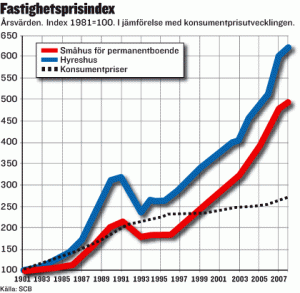 Sweden has been judged to be considerably more lenient when they calculated the risks of lower prices on the property market. The risks are calculated to be lower despite the fact that Swedish properties have increased significantly in recent years. Mortgage interest rates are clearly lower than in most other European countries and the requirements for cash deposits have also been lower until now.
Sweden has been judged to be considerably more lenient when they calculated the risks of lower prices on the property market. The risks are calculated to be lower despite the fact that Swedish properties have increased significantly in recent years. Mortgage interest rates are clearly lower than in most other European countries and the requirements for cash deposits have also been lower until now.
Gigantic housing bubble?
The respected Economist magazine had one article in July 2010 where they wrote that Swedish house prices were overvalued by 39.4%. According to the Economist, only Hong Kong, Australia and Spain had higher valued real estate markets than Sweden. China has an overvaluation of 17.1% – while there are calculations based on electricity consumption showing that there 64.5 million empty apartments and houses in China's urban areas! The problem is speculation which was recently confirmed by Land Minister Xu Shaoshi who commented that the Chinese government will cool off the real estate market.
All in all, this indicates that there may be large price drops in the future. It is a shame that the statistics presented in Sweden largely come from broker statistics which are misleading. It will be interesting how the estate agents will present their statistics in the future and which bases they will use for their calculations. They tend to be quite creative and get uncritical space in Dagens Industri. They will probably find some small group where the price drop is not visible due to small supply or change the calculation bases. Maybe they start counting with the base in 1981 - then you can still claim that the price has gone up even if the price were to fall like an avalanche. But now I would not write about broker statistics but about the stress tests.
Benchmark scenario
According to the benchmark scenario, the value of Swedish commercial real estate in Sweden is estimated to remain unchanged in 2010 and decrease by -2.5% in 2011.
In the stress tests, Sweden receives a significantly better evaluation of the Swedish housing market than other countries. The value of Swedish residential properties INCREASED by 5.0% during 2010, i.e. we have not received any reduced prices yet according to the theoretical calculations.
In 2011, the Financial Supervisory Authority thus expects unchanged prices on the real estate market despite the fact that the risk bank has announced interest rate increases. The repo rate is gradually being raised and the Riksbank's forecast is that the repo rate will approach 3% in mid-2012.
As a comparison in Spain, where they had a housing bubble, in the simpler scenario they count on a decrease in housing prices of 3.8 in 2010 and a further decrease of 5.2% in 2011. The differences between how the different countries calculate become enormous.
If Sweden is in a housing bubble, there should be a significantly larger reduction in 2011 - although it is clear that the politicians do not want expectations to cause prices to decrease. Property prices must at all costs be kept up with interest deductions and abolished property taxes. When we also have a low interest rate, everyone is happy. The Governor of the Riksbank himself says in a chat from 1 July this year that a normal interest rate at normal times is approximately 4%.
In a worst case scenario (adverse = harmful)
In a worst case scenario, the various countries' supervisory authorities expect a worse economic downturn. In this scenario, the Financial Supervisory Authority assesses that the value of Swedish commercial properties will decrease by 12.5% in 2010 and -15% in the following year. The value of Swedish residential properties decreases by -7.5% in 2010 and by -12.5% in 2011. Should it decrease with these figures, it is still significantly lower than what the Economist estimates that the overvaluation is at 39.4%.
By way of comparison, the Spanish supervisory authority expects the value of commercial properties to decrease by more than twice as much as in Sweden in a worst-case scenario. In Spain, they make risk assessments based on the fact that these properties decrease by -35% in 2010 and -30% in 2011. They expect housing prices to have smaller decreases, i.e. -8.8% in 2010 and -15.2% in 2011. Consider then that Spain's market already has had a decline. The differences in how different countries count vary to a very high degree.
It is against this background that the press release "New loans should not exceed 85 percent of the home's market value” which came from the Financial Supervisory Authority earlier this summer should be seen. The risk of a fall in the real estate market poses a serious threat to Sweden's economy. Despite that, the mortgage ceiling is criticized by, for example, the banking association because they believe that the proposal is not competitively neutral vis-à-vis Denmark and Finland, where the level is 90%.
The Financial Supervisory Authority writes in a memo from July 2010 to household indebtedness in relation to disposable income has increased sharply over the past 15 years. Debt in relation to disposable income is now up to almost 170 percent, to be compared with approximately 120 percent in connection with the crisis of the 90s. Lending to households has increased sharply in the past two years despite the recession and higher unemployment following the financial crisis. This is largely due to rising house prices.
If you compare the month of May 2010 with last year, the total mortgage amount was 11 percent higher this year. In May 2010, the Swedish people's total mortgage was SEK 1,611 billion, which is 10.8 percent higher than in May 2009. During last year, household debt in mortgages rose by 8%.
Bospindeln.se shows an interesting graph of the market development of condominiums in Stockholm and how the prices have dropped drastically during June and July 2010 and that the number of days the object is unadvertised has increased drastically. The graph differs a lot from broker statistics where they make press releases in the strangest way about the market development.
It would be interesting to know the risk exposure of Swedish banks in terms of the financing to private individuals of housing and houses in, for example, the Stockholm region and how these points could look in a worst case scenario in combination with things going badly for the Baltics. What has happened in Sweden after mortgage requirements have been set, the unsecured loan has increased, i.e. the banks can earn even more money without collateral and they charge even higher interest for this. The Riksbank, for its part, talks about the banks taking their responsibility and sometimes mentions the possibility that mortgage lenders will be forced to have insurance against the decrease in value.
Perhaps some of these problems will become visible at Basel III?
It is a shame that Sweden's housing policy has been flawed for many years and has promoted speculation. Lending for housing loans is money that the banks have on hand for a long time, while the banks can borrow money over a short time horizon. This means that the property buyers pay interest on money that doesn't really exist. The imbalances in the national debt are managed by the Riksbank taking out loans in Sweden and abroad for the money needed via the national debt. The air money is funneled on to the banking system and lent to property buyers at high interest rates. Property buyers thus pay interest on air money. Banks don't want you to pay off your loan because they don't make any money on installments. The banks want you to pay interest, then they can continue to make money on money that doesn't exist - which we all have to pay for in the form of higher national debt and inflation. Inflation can thus be seen as an extra tax that we all pay.
The stress tests should be seen as a first step to increase transparency in the banking sector.
Basel III is a proposal that may entail tougher capital requirements for banks and may become the new international regulatory framework for bank inspection. What the Basel Committee has focused on is the banks' balance between lent money and deposited money.



